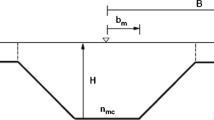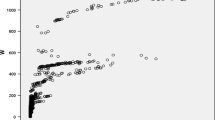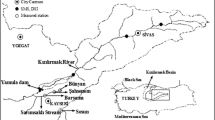Abstract
Procedures for calculating critical depth in an open channel having a trapezoidal cross section are discussed in this paper. Among the current methods are chart look-up, trial-and-error, iterative, and approximate formula; however, practical application shows that each of these methods has some problems. This paper proposes an explicit solution to critical depth in a trapezoidal channel by introducing data from iteration solution and then applying multiple nonlinear regressions (MNLR) and artificial neural network (ANN) techniques to derive the best estimate. Results show that ANN formulation of the problem of solving for the critical depth is less successful than that by regression. The performance of MNLR in terms of R2 (0.998) and RE (0.025) is excellent and performance of ANN in terms of R2 (0.987) and RE (0.132) is good but its values are slightly perturbed around its numerically obtained values.









Similar content being viewed by others
Abbreviations
- A :
-
Channel cross section area (m2)
- b :
-
Width of channel (m)
- D :
-
Hydraulic depth, D = A/T (m)
- Fr:
-
Froude Number (–)
- g :
-
Acceleration due to gravity (m/s2)
- m :
-
Side slope of channel (–)
- Q :
-
Discharge in the main channel (m3/s)
- q :
-
Discharge per unit width of channel (m3/s/m)
- R :
-
Regression coefficient (–)
- R 2 :
-
Regression determination coefficient (–)
- T :
-
Channel top width (m)
- V :
-
Mean velocity in any section of channel (m/s)
- y :
-
Water depth in channel (m)
- Z :
-
Section factor for the water depth y (–)
- Z c :
-
Section factor for the critical depth (–)
References
Azamathulla HM, Deo MC, Deolalika PB (2008) Alternative neural networks to estimate the scour below spillways. Adv Eng Softw 39(1):689–698
Bilhan O, Emiroglu ME, Kisi O (2011) Use of artificial neural networks for prediction of discharge coefficient of triangular labyrinth side weir in curved channels. Adv Eng Softw 42(1):208–214
Chaudhry MH (2008) Open-channel flow, 2nd edn. Springer, New York
Chen WB, Liu WC, Hsu MH (2011) Comparison of ANN approach with 2D and 3D hydrodynamic models for simulating estuary water stage. Adv Eng Softw. https://doi.org/10.1016/j.advengsoft.2011.09.018
Chow VT (1952) Open-channel hydraulics. McGraw-Hill, New York
Kisi Ö (2005) Daily river flow forecasting using artificial neural networks and auto-regressive models, Turkish. J Eng Environ Sci 29:9–20
Rakhandehroo GR, Vaghefi M, Shafiee MM (2010) Flood forecasting in similar catchments using neural networks, Turkish. J Eng Environ Sci 34:57–66
Salmasi F (2011) Energy loss at drops using neurosolutions. World Acad Sci Eng Technol 80:870–878
Seckin G, Akoz MS, Cobaner M, Aktanir T (2009) Application of ANN techniques for estimating backwater through bridge constrictions in Mississippi River basin. Adv Eng Softw 40(1):1039–1046
Swamee PK (1993) Critical depth equations for irrigation canals. J Irrigat Drain Eng ASCE 119(2):400–409
Swamee PK (1999) Discussion of formula for calculating critical depth of trapezoidal open channel. J Hydraul Eng ASCE 125(2):785
Wang W (1998) Formula for calculating critical depth of trapezoidal open channel (Technical Note12231). J Hydraul Eng ASCE 124(1):90–91
Wu S, Katopodis C (1999) Discussion of formula for calculating critical depth of trapezoidal open channel. J Hydraul Eng ASCE 125(2):786
Author information
Authors and Affiliations
Corresponding author
Rights and permissions
About this article
Cite this article
Salmasi, F. Critical Depth of Trapezoidal Open Channel Using Explicit Formula and ANN Approach. Iran J Sci Technol Trans Civ Eng 44, 1023–1029 (2020). https://doi.org/10.1007/s40996-020-00416-7
Received:
Accepted:
Published:
Issue Date:
DOI: https://doi.org/10.1007/s40996-020-00416-7




